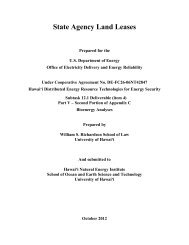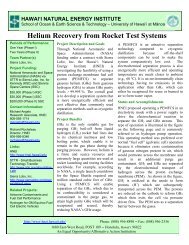Oahu Wind Integration Study - Hawaii Natural Energy Institute ...
Oahu Wind Integration Study - Hawaii Natural Energy Institute ...
Oahu Wind Integration Study - Hawaii Natural Energy Institute ...
Create successful ePaper yourself
Turn your PDF publications into a flip-book with our unique Google optimized e-Paper software.
4.0 Background<br />
In 2009 the General Electric Company, the <strong>Hawaii</strong>an Electric Company (HECO) and the <strong>Hawaii</strong><br />
<strong>Natural</strong> <strong>Energy</strong> <strong>Institute</strong> (HNEI) jointly developed power system models of the <strong>Oahu</strong> system to<br />
assess forward-looking scenarios of plausible expansions to the generation mix on the island,<br />
with a primary focus on wind plant installations. These models were developed and results<br />
validated against 2007 historical data. The models were approved by the project team for the<br />
subsequent phase of the study. In this subsequent phase of the study, GE assembled a baseline<br />
model of the power system for 2014 (the future year of study) that included new generating<br />
units, updated operating rules and forecasted system load, unit maintenance schedule, fuel prices,<br />
etc. In this report, GE will highlight the results of the scenario analysis effort.<br />
In Phase 1 of the study, models of the HECO system were developed, calibrated and validated<br />
against actual system conditions. The model consisted of three specific simulation tools: the<br />
production cost modeling tool, the transient stability dynamic model and a long-term dynamic<br />
model, which included a representation of HECO’s Automatic Generation Control (AGC). The<br />
production cost model considered the dispatch and constraints of all generation on an hourly<br />
basis and provided outputs such as emissions, electricity production by unit, fossil fuel<br />
consumption, and variable cost of production. The transient stability dynamic model considered<br />
shorter timescale contingency events (sub-hourly) and characterized the system’s ability to<br />
respond to these events. The long-term dynamic model considered critical wind variability event<br />
over less than one hour and characterized the system’s ability to respond to these types of events.<br />
The dynamic modeling tools were necessary to determine the impact of decisions made in the<br />
longer timescales (production model) on the overall system operability. Statistical analyses tools<br />
were developed to identify wind and load variability events, which were examined in greater<br />
detail in this study.<br />
The production cost model was developed to: (1) assess the variable cost of production (and its<br />
breakdown in terms of O&M, fuel, and start-up cost), (2) estimate the amount of wind and solar<br />
power curtailed, (3) quantify the overall system heat rate, and (4) describe the unit commitment<br />
and dispatch for each scenario. The production cost modeling tool (GE MAPS TM ) curtails wind<br />
and/or solar power when the units on-line cannot be backed down any further without violating<br />
their minimum power output and down-reserve requirement. Further, the production cost tool is<br />
used to initiate the dynamic model developed in GE PSLF TM , which is a tool for assessing<br />
dynamic stability of the power system. A model of the HECO Automatic Generation Control<br />
(AGC) was developed for the project in GE PSLF TM and was used to assess the unit performance<br />
and system frequency impact of the wind variability for specific events on the system.<br />
Significant interaction with the HECO and GE teams resulted in the development of a very highresolution<br />
power system model for the island of <strong>Oahu</strong>. The purpose of this modeling and<br />
analysis effort was to provide a Baseline measure of power system performance. This Baseline<br />
model is used as a reference point for infrastructure evolution scenarios that explores alternative<br />
energy futures for HECO.<br />
42




